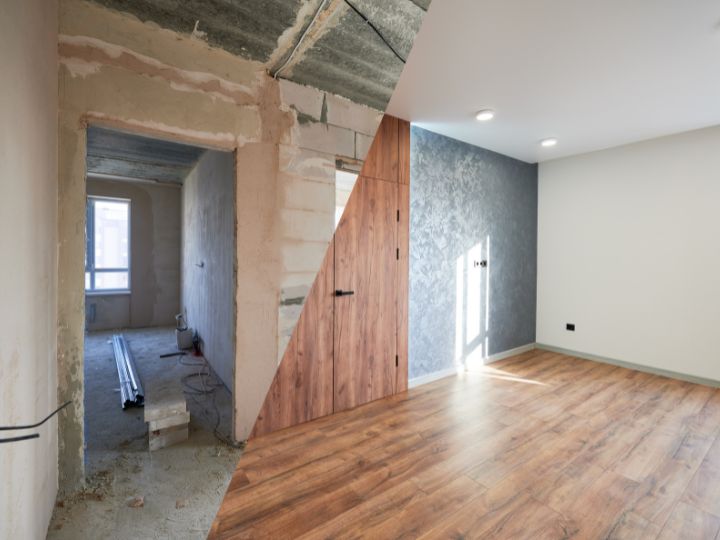
The True Cost of Waiting: Why Delaying Your Remodel Might Cost More

Delaying your home remodeling project could cost you significantly more money due to ongoing construction inflation, rising material costs, and increasing labor expenses. Current data shows construction costs continue to rise at 3-4% annually, making today's prices tomorrow's "good deal."
You've been thinking about that kitchen remodel for months, maybe even years. Perhaps you're considering a bathroom upgrade or dreaming of finishing your basement into a functional living space. While it's natural to want to plan and save for such significant investments, waiting too long could end up costing you more than moving forward with your project today.
The Current State of Construction Costs
The construction industry has experienced significant cost fluctuations in recent years, and the trend shows no signs of slowing down. According to the latest Mortenson Construction Cost Index, construction costs went up 2.2% in the first quarter of 2025 and are up 3.9% compared to a year ago. This consistent upward trajectory means that the project you're considering today will likely cost more if you wait until next year.
Construction cost inflation typically runs about double the consumer price index (CPI), with long-term construction cost inflation normally about double consumer price index. This means while general inflation might hover around 2-3%, construction-specific costs often increase at 4-6% annually or higher during periods of high demand.
Understanding the Drivers Behind Rising Costs
Material Cost Inflation
Building materials made of copper had some of the highest price growth rates in the U.S. in November 2024 in comparison to the previous year. Key construction materials continue to see price increases across the board:
- Lumber and wood products remain volatile due to supply chain factors and environmental regulations
- Steel and metal components face ongoing pressure from global demand and trade policies
- Electrical and plumbing materials have seen consistent increases due to raw material costs
Labor Shortages Drive Up Costs
The cost and procurement of labor remains a critical challenge to construction, with various industry sources estimating a need for 450,000 to 550,000 new craft workers above the normal pace of hiring in 2024 just to meet demand. This shortage directly impacts pricing in several ways:
- Increased wages to attract and retain skilled workers
- Longer project timelines due to scheduling constraints
- Premium pricing for experienced craftspeople
- Overtime costs becoming more common
Supply Chain Complexities
Even as supply chains have stabilized compared to the disruptions of 2020-2022, challenges remain. Persistently long lead times for electrical equipment are adding to the cost of many building and infrastructure projects. These delays can impact your project in multiple ways:
- Extended project timelines increase overall costs
- Rush orders often carry premium pricing
- Storage costs for materials delivered early to avoid delays
- Potential design changes due to unavailable specified products
The Real Cost of Waiting: A Breakdown
Year-Over-Year Price Increases
Based on current trends, here's what waiting could cost you on typical remodeling projects:
Kitchen Remodeling Projects:
- $50,000 project today → $52,000-$53,000 next year
- $100,000 project today → $104,000-$106,000 next year
Bathroom Renovations:
- $25,000 project today → $26,000-$26,500 next year
- $40,000 project today → $41,600-$42,400 next year
- $75,000 project today → $78,000-$80,000 next year
- $150,000 project today → $156,000-$159,000 next year
These calculations are based on current construction cost inflation rates of 3-4% annually, which industry experts expect to continue through 2025.
The Compound Effect
What makes delaying particularly costly is the compound nature of construction inflation. Construction inflation should always be calculated from current cost to midpoint of construction. If you wait two years instead of one, you're not just facing 6-8% increases – you're looking at compounded inflation that could push your project costs 10-15% higher than today's prices.
Hidden Costs of Delay
Beyond direct cost inflation, waiting can create additional expenses:
Opportunity Costs:
- Lost enjoyment of your improved living space
- Potential decrease in home value relative to neighborhood improvements
- Continued inefficiencies in outdated kitchens, bathrooms, or heating systems
Market Timing Risks:
- Contractor availability becoming more limited
- Having to settle for less preferred timing or scheduling
- Premium pricing during peak construction seasons
When Waiting Makes Sense
While the trend suggests acting sooner rather than later, there are situations where strategic waiting might be beneficial:
Budget Planning
If you need time to save for a larger portion of the project to avoid high-interest financing, the savings on interest might offset construction inflation.
Design Development
Taking time to fully develop your vision and plans can prevent costly change orders during construction, which typically cost 20-30% more than original work.
Seasonal Considerations
For certain exterior projects, waiting for optimal weather conditions can result in better quality work and potentially lower seasonal pricing.
Strategies to Minimize Cost Impact
Lock in Pricing Early
Many remodeling contractors can provide pricing that's valid for 30-90 days, allowing you to secure current rates while finalizing financing and permits.
Phase Your Project
Consider breaking larger projects into phases. Complete the most critical or cost-sensitive portions first, such as structural work or major system updates.
Partner with Established Contractors
Working with experienced general contractors who have established supplier relationships can help minimize material cost volatility and ensure better scheduling.
Material and Labor Cost Forecasts
Looking Ahead to 2025-2026
Globally, construction costs are anticipated to rise at a similar rate in 2025, by 3.4 percent, with North America expecting increases of 3.0 percent. Industry forecasts suggest:
- Materials: Continued modest increases of 2-4% annually
- Labor: Stronger growth of 4-6% due to ongoing shortages
- Energy costs: Potential volatility due to policy changes and global factors
The Trump administration's push for higher tariffs is reigniting concerns around higher costs ahead for real estate developers, as a tangible portion of materials—including lumber, cement, and steel—are imported.
Regional Variations
Cost increases aren't uniform across all markets. While national averages provide guidance, local factors significantly impact pricing:
- Urban areas typically see higher labor cost increases
- Regions with strong population growth face more material demand pressure
- Areas with limited contractor availability experience premium pricing
Making the Decision: Act Now or Wait?
Financial Readiness Assessment
Before deciding whether to proceed or wait, evaluate:
- Current financial position – Can you comfortably afford the project without overextending?
- Financing options – Are current interest rates favorable compared to projected future rates?
- Project urgency – Are there safety, efficiency, or functionality issues that justify immediate action?
The Sweet Spot Strategy
The optimal approach often involves finding the sweet spot between adequate planning and market timing:
- Immediate planning: Start design and permitting processes now
- Contractor selection: Interview and select your remodeling contractor during less busy periods
- Phased execution: Begin with the most critical or cost-sensitive elements
Beyond Cost: The Value of Acting Now
Quality of Life Improvements
The benefits of moving forward with your remodeling project extend beyond financial considerations:
Daily Enjoyment: Every month you wait is another month without the improved functionality and aesthetics you're seeking.
Energy Efficiency: Modern kitchen appliances, bathroom fixtures, and insulation improvements can provide immediate utility savings.
Home Value: Strategic improvements can increase your home's value and marketability, particularly important in competitive real estate markets.
Avoiding Future Complications
Delaying necessary improvements can lead to more extensive and expensive problems:
- Plumbing and electrical systems: Aging infrastructure often requires more extensive updates when finally addressed
- Structural issues: Small problems can become major structural concerns over time
- Code compliance: Building codes evolve, potentially requiring more extensive work in future projects
Working with the Right Contractor
Choosing Experience and Stability
During periods of cost volatility, working with an experienced general contractor becomes even more critical. Look for contractors who:
- Provide detailed, fixed-price bids that account for potential cost fluctuations
- Have established relationships with suppliers for better material pricing and availability
- Offer transparent communication about potential cost factors and project timelines
- Demonstrate a track record of completing projects on budget and on schedule
The Thornapple Construction Advantage
At Thornapple Construction, we understand the challenges homeowners face when considering remodeling projects in an inflationary environment. Our approach includes:
- Fixed pricing commitments to protect you from cost escalation during your project
- Established supplier relationships that help minimize material cost volatility
- Efficient project management to reduce labor costs and timeline extensions
- Transparent communication about market conditions and their potential impact on your project
Taking Action: Your Next Steps
Immediate Actions
- Get current pricing: Obtain detailed estimates for your project to establish baseline costs
- Understand your financing options: Explore current interest rates and loan terms
- Begin the design process: Start developing detailed plans and specifications
- Research contractors: Interview potential contractors and check references
Planning for Success
- Set realistic timelines: Account for design, permitting, and construction phases
- Establish contingency budgets: Plan for 10-15% above estimated costs for unforeseen issues
- Consider seasonal factors: Plan construction timing to optimize weather conditions and contractor availability
Conclusion: The Cost of Inaction
While no one can predict future cost movements with complete accuracy, current trends strongly suggest that construction costs will continue rising. The data shows construction costs went up 2.2% in just the first quarter of 2025 and are up 3.9% compared to a year ago, indicating that waiting will likely result in higher project costs.
The decision to move forward with your remodeling project shouldn't be made solely on the fear of future cost increases, but rather on a comprehensive evaluation of your needs, financial readiness, and long-term goals. However, if you're already considering a project and have the means to proceed, current market conditions suggest that sooner is likely better than later.
Whether you're dreaming of a complete home remodeling, planning a strategic home addition, or ready to transform your basement into a luxury living space, the best time to start planning is now.
Ready to discuss your remodeling project? Thornapple Construction offers free consultations to help you understand your options and make informed decisions about timing and investment. Our experienced team can provide current market pricing and help you develop a strategy that maximizes value while minimizing cost risk.
Latest Blogs
Transform your dream home into reality with our premier renovation services!
Book a call with us today and let's create the perfect space tailored just for you.

.svg)
.svg)



